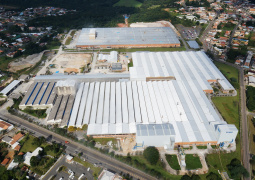Incepa Responds: how to choose the best wall tile for your beach house

Summer is coming and we can only think of one thing: enjoying a beach vacation. After all, nothing better than relaxing in the sun, with your feet in the sand, and listening to the sound of the sea. However, anyone who owns a house on the beach or intends to build one may face a problem: wear of the wall tile.
Unfortunately, when choosing a wall tile for coastal houses, some care is needed, considering that it will be in constant contact with sea air and sand. To help them avoid headaches, we’ve separated some tips and suggestions for wall tiles. Keep reading and check it out!
What is the ideal wall tile?
When we are choosing the wall tile for our beach house, some points need to be taken into account:
- Humidity: due to the proximity of the sea, environments are usually very humid; ideal for the emergence of fungi, slime, mold, and infiltrations.
- Salt spray and sand: Salt spray and water splashes can cause long-term corrosion, especially on metal surfaces. Also, grains of sand can scratch the floor if you choose the wrong finish.
- Finishing: each environment requires a specific type of finish. It is recommended that the wall tile used in the internal area, for example, is not the same as in the external area.
To meet all specifications, we suggest porcelain wall tiles. They are very resistant to damage caused by the sea air and have very low porosity – between 0.1% and 0.5%. This ensures that they absorb little water and are more resistant.
Wall tiles most appropriate for each room in the house
As we said earlier, each area of the house requires a specific finish wall tile. Check out which one is ideal for each of them!
Internal environments
Due to the presence of sand, the wall tile ends up being more susceptible to scratches. Generally speaking, the brighter the surface, the less resistant and more prone to scratches it will be. Therefore, we recommend porcelain tiles with a natural and dull finish, such as Incepa’s Técnico and Tuttomassa porcelain tiles.
It is worth mentioning that the scratch resistance of porcelain tiles is measured by the degree of surface hardness, obtained according to the MOHS Scale. To this end, tests are carried out with several stones to check which ones could scratch the surface. At level 1 we have Talc and at the last level, we have Diamond. However, level seven, which corresponds to Quartz, already scratches most enameled floors.

Wall tile Tuttomassa 
Wall tile Alpha Technical
Outdoor environments
In outdoor environments, it is essential to choose wall tiles with slip resistance, since the floor is constantly wet, increasing the chances of slips, falls, and other accidents.
As it characterizes a surface as to the ease or not of slipping, it is the Wet Friction Coefficient. According to the product standard, linings must have a coefficient of friction of <0.40 for indoor installations that do not require slip resistance, and ≥0.40 for locations that require resistance.
To meet the demand of those who want to cover the exterior of the house safely without sacrificing aesthetics, Incepa developed porcelain tiles with an ABS finish. It has a Wet Friction Coefficient >70, which guarantees a product with 30% greater adhesion than other conventional finishes.
Another characteristic of this finish is that despite its high coefficient of Moist Friction, its surface is not as rough when compared to natural stones or traditional non-slip wall tiles. This is because Roca Brasil Cerámica, the group of which Incepa is a part, has an exclusive and finer grit, keeping it easy to clean.
Regarding the print, it is possible to opt for dark tones to disguise the constant presence of sand. However, the light shades are great for highlighting the grains of sand and helping you keep the environment cleaner.

Wall tile Pro Max 
Wall tile Quartzita
After reading, we hope that you make the correct wall tile and enjoy the summer without any worries. 🖤







